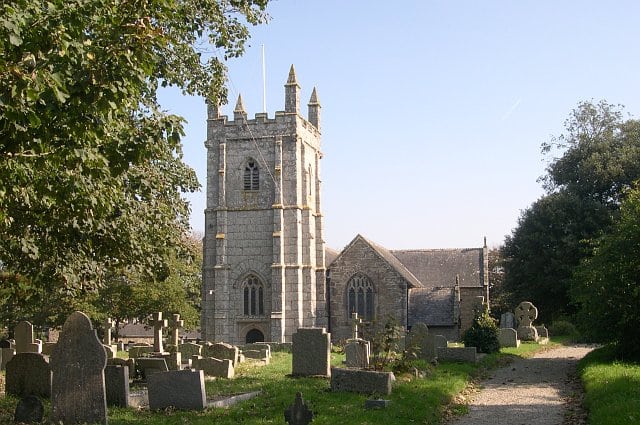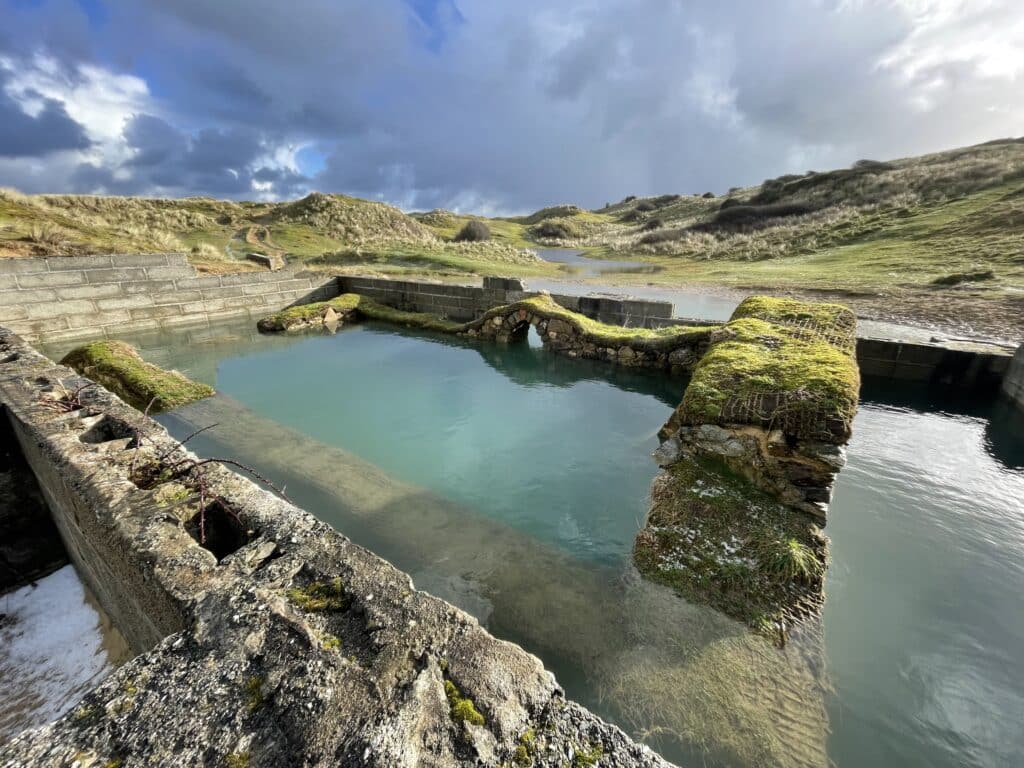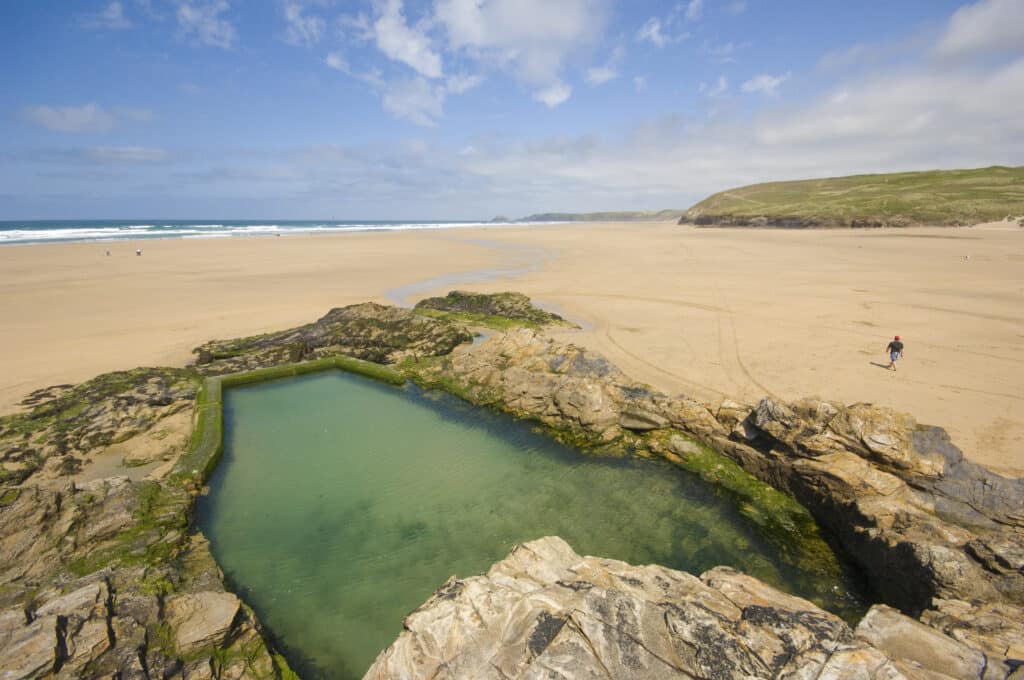St. Piran – who was he and why is he patron saint of Cornwall?
Who is St Piran and where did he come from?
St Piran was born in Ireland in the 5th Century and after he studied the scriptures in Rome, he returned to Ireland and was made a Bishop. Legend has it that his miracles started by resurrecting dead soldiers from battle but this didn’t impress the Kings of Ireland much. So unimpressed were they, they tied a millstone around his neck and threw him into a stormy Irish sea. That’s when the next miracle happened as the sea calmed and he floated across the sea, unharmed, to land on the Cornish beach – Perranporth. His first disciples were said to be a badger, a fox and a bear.
St. Piran was a hermit and his austerity and holiness won him admiration from all around as well as his ability to perform miracles attracting many who sought his charitable aid.
Another reason for his saintliness and how the Cornish flag came into effect is his re-discovery of tin. Tin had been smelted since before the Romans but the methods had been lost. St. Piran re-discovered it by laying a fire on black rock and after a time a white liquid oozed out in the form of a cross. Hence, it is said, the Cornish flag was born and tin was mined.
Fun Fact:
Did you know that tin mining in Cornwall was so important to the country in the Middle Ages, King Edward III granted the creation of the Duchy of Cornwall giving all Cornish miners exemption from civil law. Sadly, that no longer applies!
St. Piran’s Church and Oratory
As we are approaching St. Piran’s Day on March 5th, knowing of the Oratory and Church’s existence, I thought it would be a good idea to go in search of them and understand a bit more of their importance. Both ruins are in the dunes around Gear Sands about a mile from the coast of Perran Bay. Using the iWalkCornwall App that has a guided 3.6-mile walk (Lost Church and Perranporth Dunes walk) incorporating both sites, I set off on what must have been the coldest, windiest day in January!
I took our three dogs (the Orange Roofs office dogs!), Shep, Hops and Toast and roped in my husband Ross (the other owner of Orange Roofs) to capture our adventure on video. I’m so pleased we did, given we had the joy of seeing four Choughs at the end of our walk. The chough is the symbol of Cornwall – it is on the Coat of Arms and, according to legend, King Arthur turned into a chough on his death.
Here is part one of our walk as we head out to find St. Piran’s Cross and the Church which was built around 1150 and enlarged in the 15th Century.
St. Piran’s Church, otherwise known as the ‘second’ church attracted pilgrims who believed St. Piran’s bones were buried there. It was built because the older Christian chapel called the Oratory, built around the 7th Century, became completely buried by the sand. The association with St Piran to the site of the Oratory is mentioned in the Domesday Book of 1086 where a monastery was recorded as Lanpiran denoting an early Christian foundation.
St. Piran’s Church (which is only a short distance uphill from the Oratory) dates back to the late 12th Century while St. Piran’s Cross (that marks you’re close to the church ruins!) dates back to the 11th Century or earlier. The oldest remaining part of the church is the chancel measuring 9m by 6m. It too was engulfed by sand blowing in across the dunes and abandoned in 1804. At the beginning of the 19th Century, with the sands shifting, parts of the Church were visible. In 1835 and 1843 the inside of the monument was cleared right down to the original floor levels and there was some internal rebuilding of a new altar inscribed ‘Sanctus Piranus’. Much of the material from the Church was relocated 2.5km inland to build the ‘new’ St. Piran’s Church at Perranzabulue.

Perranzabuloe Church
The next part of our walk took us to the Oratory and it really did feel a very mystical, holy site.
The water that had flooded the Oratory was incredibly beautiful and it was pretty difficult to get our heads around the fact that beneath the water stood a church built in 700 AD and was used until around the 12th Century. Rather darkly, a graveyard surrounds this early Christian chapel but what a place to be laid to rest.
So, what exactly is an Oratory?
Oratory comes from the latin word orare meaning ‘to pray’. It is a small chapel and offers a place for private worship. St. Piran’s Oratory is a grade II listed building and has close similarities to early Christian oratories in Ireland. It is rectangle in plan with the outside measuring just 9.5m by 5m. It would have been a cosy place to go and worship. There is no significant evidence how much of the surviving chapel masonry dates back to the 7th Century but there is an inscribed stone, largely illegible believed to be an early Christian memorial stone.
By the 12th Century, the Oratory was swallowed by sand which is why St. Piran’s Church was built just a short walk away.
St. Piran’s Oratory is surrounded by pretty ugly concrete blocks now which originally had a roof on it making it look a little like an airplane hangar. Decades of vandalism and the elements has left it in its current state as you see today but it is still doing a good job of protecting the integrity of the ruins. If you can look past the concrete blocks, the sight of this incredibly old ruin really is worth the walk.

St. Piran’s Oratory
Beaches around Perran Bay
Leaving St. Piran’s Church and Oratory behind us, we continued our walk guided by iWalkCornwall. It took us through Penhale Sands which is the largest dune system in Cornwall and the highest in Britain, as high as 90m and the sand is nearly 50m deep. No wonder churches got swallowed up by it! Most of the major dunes on the North Cornish coastline are thought to have been formed 5000 years ago when the sea levels finally stopped rising after the last big Ice Age melt.
As we know, St. Piran miraculously floated across the sea until he washed up at Perranporth. This beach is most definitely worth a visit and is well known for its great surfing.

Perranporth Beach where St Piran first landed in Cornwall
The walk skirts along the coast path where the large Perran Sands Holiday Park sits above. It was built on the old tin mine site of Wheal Vlow. The view out to sea is to Ligger Point and Carter’s Rocks at Holywell Bay sticking out just beyond it.
At high tide, there are two beaches within Perran Bay; the long thin Perran Beach (between Carn Clew and Ligger Point) and the smaller Perranporth beach to the south between Cotty’s Point and the river beside Chapel Rock.
At low tide, these two beaches merge into a delightful 2.2 mile stretch of sand between Droskyn Point and Ligger Point and can be up to a quarter of a mile wide. There is a tidal swimming pool and the northern end of the beach is normally quieter (given Perranporth and holiday parks are to the south).
The day we did our walk, the tide was high so we stayed on the coast path which led up to Gear Sands. On the way we passed a granite bench dedicated to Winston Graham. You would know him if I mentioned Poldark. It is thanks to Winston Graham that Ross Poldark lives in our hearts…
Winston Graham moved to Perranporth in 1925 aged 17 and lived there for 34 years where he wrote the first four Poldark books.
The walk cuts right through the heart of a golf course. Nobody in their right mind would have wanted to play golf in the weather we walked in so there was no need to dodge golf balls! It was as we walked up a small hillock that we were met with two Choughs. They were no more than 5 metres away and nonchalantly grazed on the short grass. Their cry is distinct and sounds like their saying ‘’Ciao’’ in a screechy voice. Their beaks are bright orangey/ red and their bodies a compact black. To begin with, I thought I’d walked in on a crow but it dawned on us both just how lucky we were. Ross started filming and one flew away but the other didn’t seem too fazed. He panned around and to our delight, there flew another three. It couldn’t have felt any more of a Cornish celebration right there.
Fun fact number two:
St.Piran was known to like his alcohol and so on the 5th of March, celebrations for St. Piran’s Day involve lots of booze and have given rise to the expression ‘’drunk as Perraner’’! Who’s in?
Article written by Sam Sheppard
